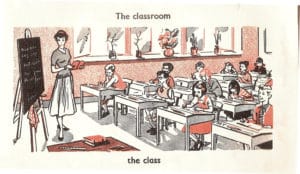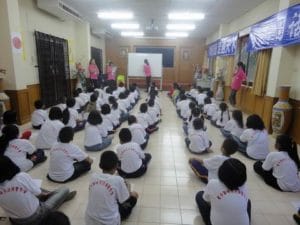Parents, have you ever wondered which pedagogical method your kids’ language teachers use ? They have changed drastically over time, catering to different needs – and achieving uneven results.
Many years ago, a Russian teacher was telling his young students about one of his best-appraised former classmates. He was a Frenchman learning Russian, who had perfect grammatical command and boasted an unmatched vocabulary. He only had one very small issue – which incidentally had never impacted his academic progress in any way: he was completely unable of holding any conversation whatsoever in Russian.
Our unfortunate student was just another victim of the most traditional pedagogical system used in second language teaching: the Grammar Translation method. The focus is on formal knowledge of the language and, more specifically, its grammar. The learning is deductive: master of his class, the teacher presents grammar rules and gives his students exercises for practice. Translation is among the most favored activities. This way of teaching does not aim at making the language a communication tool at all. It is rather similar to teaching classical or liturgical languages such as Ancient Greek, Latin, and to some extent Sanskrit. The approach, predominant in 19th century Europe, can only be found today in isolated pockets.
he audio-lingual method, born in the middle of the 20th century in the US, is based on behaviorist theories. With a great focus on oral and aural aspects, it undertakes to teach languages through repetition and drill. A variation of it, developed in the UK, is the PPP method : Presentation (of a concept), Practice (by exercises), and Production (by students). Sentences given by the teacher are repeated multiple times and learned by heart so as to develop automaticity. Exercises typically consist in variations of these sentences, for instance by substituting a word.
The audio-lingual approach fell quickly under fire from critics and had been by and large discredited since the 70s. As Harmer (2001) points out, “Audio-lingual methodology seems to banish all forms of language processing that help students sort out new language information in their own minds.” It has nevertheless survived in numerous parts of the world.
Across the Chinese world, for instance, rote learning and repetition are still widespread at the expense of communication. Shumei Zhan (2009) reminds us that oral communication for English-learning Chinese remains very challenging, “even though they might be able to read Shakespeare’s works in original after years of study at school”. The Chinese also know how to laugh about it. A joke goes that one day, a young girl learning English falls off her bike and is stuck in a pit. An American comes by and asks : “Hello, how are you ?”. The little girl answers mechanically: “I am fine, thank you, and you ?”. The American, slightly puzzled, replies that he is fine too and goes away.
In counter-reaction to the audio-lingual method, the 1970s saw the emergence of Communicative Language Teaching methods, where communication is not only the goal of but also the method of learning. The new educational paradigm uses implicit learning in authentic contexts, and not explicit learning in an artificial environment. Grammar is no longer taught, sentences are no longer repeated over and over again. Learning takes place through communication events such as conversations. Defined in a very flexible manner and without any real theoretical foundation, communicative teaching methods give birth to numerous variations. One such variation, a distant relative, builds on non-linguistic tasks to be carried out in the target language.
The first generation of Communicative Language Teaching also received its good share of criticism. Its effectiveness, to start with, has been questioned. Dornyei (2011) reminds us that pure implicit teaching of foreign language, including immersion, has not really lived up to expectations. Cultural barriers have also emerged: in the Confucian world, for example, removing the teacher from their central role to being a simple facilitator is not well taken. Finally, CLT does not meet needs as they are still expressed in many countries: passing exams which themselves focus on grammar and vocabulary.
CLT is undergoing significant change. In one of its most interesting developments, Dornyei advocates Principled Communicative Approach (PCA) which we will tackle in a future post. PCA combines implicit and explicit teaching in a structured way in order to achieve communicative competence alongside linguistic accuracy.
There is no single methodology that can consistently be rated the best. The correct approach is the one that meets the learner’s objectives, and that can be implemented in the learner’s environment. Anyway, as Canagarajah (1999) points out, what teachers practise in language classrooms rarely resembles any specific method as it is prescribed in manuals.
For more information :
– Dörnyei, Z. (2013). Communicative Language Teaching in the twenty-first century: The ‘Principled Communicative Approach’. In J. Arnold & T. Murphey (Eds.), Meaningful action: Earl Stevick’s influence on language teaching (pp. 161-171). Cambridge: Cambridge University Press.
– Shumei Zhang (2009). The Role of Input, Interaction and Output in the Development of Oral Fluency. English Language Teaching. December 2009
– Richard Badger, XiaoBao Yan (2009). To what extent is communicative language teaching a feature of IELTS classes in China. IELTS
– Jack C. Richards (2006). Communicative Language Teaching today. Cambridge University Press
– Jeremy Harmer (2001), The Practice of English Language Teaching.Essex: Pearson Education Ltd.







